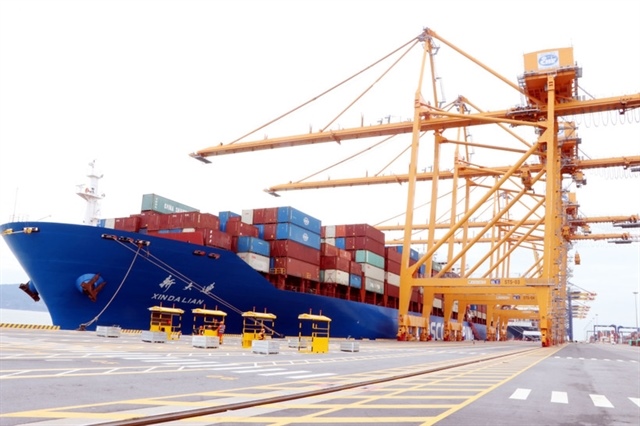VN support industries striving to improve
VN support industries striving to improve
Vietnamese enterprises have the potential to participate in regional and global production value chains on par with the leading countries in ASEAN, because Viet Nam has been a top priority choice of multinational corporations.

However, in order to realise this goal, in addition to their own efforts, businesses also need the support of the State.
In the draft plan for sustainable development of Vietnamese private enterprises, the Ministry of Planning and Investment (MPI) aims to raise the rate of enterprises participating in regional and global production networks and value chains, equal to the leading countries in ASEAN 4 by 2030.
In fact, it is not easy to achieve this target. Statistics from the MPI show that Viet Nam has only 21 per cent of small- and medium-d enterprises (SMEs) participating in global value chains, while this figure in Thailand is over 30 per cent and Malaysia is 46 per cent. Therefore, in order to improve rankings in ASEAN, it is certain that Vietnamese enterprises must “go faster”.
However, that does not mean that businesses need to be afraid because Viet Nam has a number of opportunities. Evaluating the opportunities for Vietnamese enterprises to participate more deeply in the global value chain, Minister of Industry and Trade Tran Tuan Anh said that the recent change in global value chains had placed Viet Nam in a more important production base.
Previously, some East Asian countries such as Japan and the Republic of Korea chose China and ASEAN countries as production bases for export to their trading partners. However, China is gradually becoming a consumer market instead of a manufacturing centre, especially in the context that the US-China trade war may take a long time, so ASEAN countries, especially Viet Nam, have the opportunity to become an alternative destination for investment.
Recent trade conflicts have accelerated the process of moving some manufacturing stages from China to Viet Nam.
‘China + 1 Strategy’
“China + 1 Strategy” is being pursued by multinational companies to find another nation besides China to avoid a rapidly growing trend of labour wages in China, but this country needs to be close enough to export back to China.
With the above criteria, along with joining a series of free trade agreements (FTA) recently, Viet Nam has been the first priority choice.
However, the Minister of Industry and Trade also acknowledges that this issue cannot be implemented in a short time if Viet Nam does not soon upgrade production capacity and restructure the economy towards industrialisation.
Moreover, the Vietnamese industry faces a number of challenges. While many countries participate in the entire value chain from design, production to assembly and distribution, Viet Nam mostly participates in the lowest part of the value chain - in assembling stage - and is dependent on multinational corporations.
Currently, Vietnamese labour costs are increasing and can no longer be a competitive advantage. Therefore, if Viet Nam cannot boost technology application and make use of technology transferred from foreign direct investment (FDI) enterprises, the country will lose the opportunity to accelerate the industrialisation and modernisation of the country.
Currently, textile and electronics are two large sectors. Each year, Viet Nam exports nearly US$30 billion of textile products and nearly $70 billion of electronic products and components, but supporting industries in these two sectors have not yet developed strongly.
Regarding supplying parts to the automotive industry, Viet Nam has less than 100 first tier suppliers while Thailand has nearly 700. Thailand has about 1,700 second and third tier suppliers, Viet Nam has less than 150. Automotive components currently produced in Viet Nam are mainly simple parts, such as seats, glass, tires and tubes.
Change in policy
According to Dr Huynh The Du from Fullbright University Viet Nam, the country has not yet exploited or is not ready to exploit the benefits of FDI sector such as learning experiences and linking to the global economy. Meanwhile, the FDI sector has become main contributors to the domestic economy.
Due to the limitations in research and development, domestic enterprises are unable to connect or become suppliers of auxiliary products or services for FDI enterprises, especially complex components.
Le Duong Quang, president of the Association for Supporting Industry in Viet Nam, said the difficulties that Vietnamese enterprises faced when participating in the supply chain was that some manufacturing industries have frequent changes in product designs (such as the change in models of mobile phones every year).
This forces businesses to have very careful calculations and considerations and must have good management capacity to meet the requirements if they want to join in the supply chain.
Besides, there are still limitations in the State’s policies. For example, textile and footwear enterprises say that localities do not have specific plans for zoning auxiliary industries, for raw material areas and there have been no practical policies to encourage the processing of domestic raw materials.
According to the draft plan for sustainable development of private firms, the MPI will chair the study of an SME support programme for 2020-30, taking advantage of opportunities and benefits from FTAs, focusing on promoting business links and encouraging businesses to participate in global value chains.
At the same time, the Ministry of Industry and Trade will develop a scheme to support SMEs to join the value chain of key industrial products of Viet Nam in the 2020-25 period while the Ministry of Agriculture and Rural Development will take the responsibility in formulating a scheme to support SMEs in Viet Nam’s key agricultural product value chains in the period of 2020-30. These documents will be submitted to the Prime Minister this year.
























